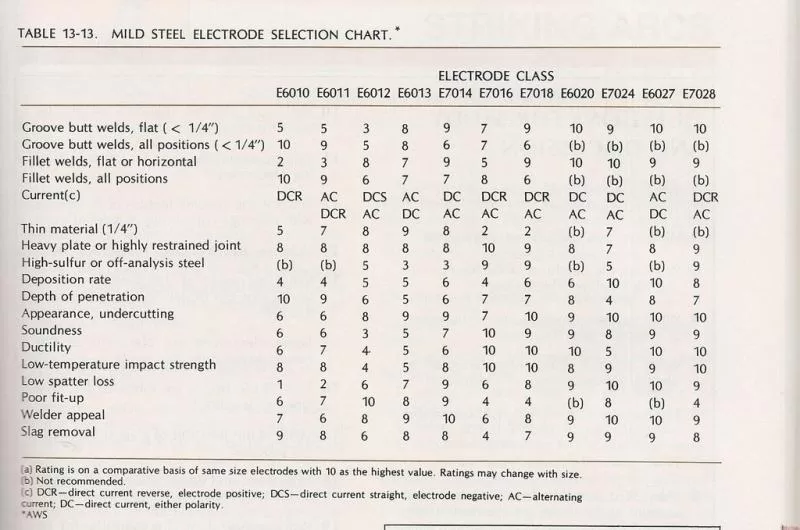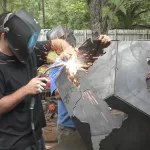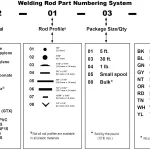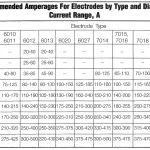In this article you will learn about the different between 7014 and 7018 soldering electrodes – we will consider coatings, solidification times and compatible metals!
Difference for 7014 vs 7018 Welding Rod
Welding Town
Choosing the right welding rod for a welding project can be one of the trickiest decisions for most if not all, beginners. With so many welding electrodes on the market, it’s easy to see why many welders struggle to choose the right one. Trust us, you don’t want to make the wrong decision here, especially if you’re on a budget.
When it comes to arc welding, weld rods 7014 and 7018 are household names, but because of their similarities, many welders have a hard time telling the difference between them. If that’s the case for you, we’re going to compare 7014 and 7018 welding rods to help you understand the differences between the two materials.
Additionally, the difference between welding electrodes 7014 and 7018 is based on a variety of characteristics, such as coatings, storage conditions, tensile strength, compatible metals, and more. Read on to learn about the various factors that differentiate these two welding electrodes and see which one is better for you.
7014 Rod Overview
The welding electrode 7014 is designed for arc welding. It is coated with titanium dioxide and iron powder. This electrode is favoured by welders for its ease of use, good performance and impressive welding characteristics. For example, it can be used in all positions, but works best in the flat position.
In addition, welding rod 7014 is primarily used for welding low-metal alloys. This makes it ideal for home welding. There is no shortage of 7014 welding rods on the market. According to most reviews, Forney 32005 E7014 is a high-quality all-position welding rod. In addition, it requires minimal surface preparation for use.
Parameters
Code: AWS A5.1 ASME SFA 5.1, F-3, A-1
Current: DC & AC
Diameter: 1/16”, ¼”, 3/32”, 1/8”, 5/16” 5/32”, 3/16”
Tensile strength: 70,000 PSI
7018 Rod Overview
Welding rod 7018 is also designed for arc welding. It is also known as a low-hydrogen electrode because it is coated with a low-hydrogen, iron-based flux compound. Like the weld rod 7014, weld rod 7018 performs well. However, this electrode is complicated to use and is not suitable for beginners or amateurs. For this reason, these welding electrodes are mainly used for large-scale projects.
You can find a wide range of welding electrodes 7018 on the market, but you have to choose a reliable electrode like Forney 30705 E7018, which is very easy to use and doesn’t require a high level of penetration. It is also ideal for out-of-position welding of cold rolled steel and general fabrication.
Parameters
Code: AWS A5.1 ASME SFA 5.1, F-4, A-1.
Current: DC & AC
Diameter: 1/16”, ¼”, 3/32”, 1/8”, 5/16” 5/32”, 3/16”
Tensile strength: 70,000 PSI
Difference for 7014 vs 7018 Welding Rod
As we hinted at earlier, it can be a little difficult to tell the difference between 7018 and 7014 soldering rods. For your convenience, we will compare 7014 and 7018 welding rods and analyse the differences between them.
Coating
Welding electrodes 7014 and 7018 are two different welding electrodes as far as the flux coating is concerned. In addition, the different flux coatings are the only structural difference between the two electrodes. 7018 electrodes are flux coated with low-potassium iron hydroxide, as they are designed for welding high-carbon steels. The 7014 electrode is coated with titanium-iron powder.
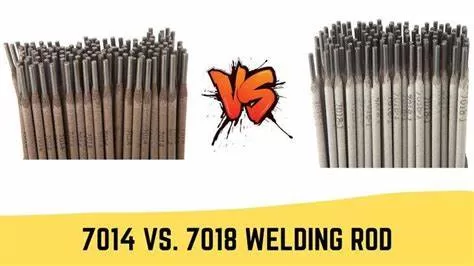
Nothing says the difference in coatings like the fourth digit of each type of electrode. the “4” in 7014 electrodes means “titanium-iron powder”, while the “8” in 7018 electrodes means “low hydrogen iron powder”. These are based on the American Welding Society (AWS) coded classification of welding electrodes, approved by the American National Standards Institute (ANSI).
Storage conditions
As far as storage conditions are concerned, welding electrodes 7014 and 7018 are different. Therefore, you should not make the mistake of storing them under the same conditions.
Remember that welding rod 7014 has a titanium coating and is suitable for storage in a humid environment. The 7018 electrode has a low-hydrogen coating and is therefore not suitable for storage in a humid environment. You will need to place the electrodes in an oven before use.
Obviously, welding rod 7014 is more suitable for storage than welding rod 7018.
Price
Price is another factor that distinguishes between welding electrodes 7014 and 7018. The price of these two types of rods varies by weight. For example, a 5-pound 7014 can cost between $15 and $25, while a 10-pound 7018 can cost between $30 and $45. The exact price usually depends on the manufacturer.
Although the price difference between the two electrodes was not significant, we noted that the 7014 electrodes were more expensive. We compared the prices of many products and found that 7014 was always more expensive than 7018.
Compatible metals
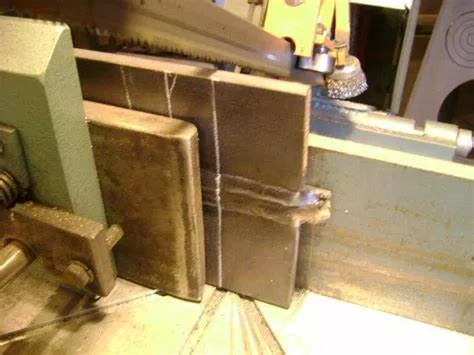
Welding electrodes 7014 and 7018 differ slightly in terms of compatible metals. Both can be used on carbon and low alloy steels. However, weld rod 7018 is not limited to this, as it is also compatible with other metals, such as high-carbon and high-strength steels. So, if you need an electrode for a wider range of metals, 7018 is the way to go.
Freeze Time
When it comes to freezing time, Welding Rod 7018 takes the cake. This electrode has a fast freezing capability that 7014 does not have, and 7014 is a filler-frozen iron powder-coated electrode. As a result, it has a shorter freezing time than 7018.
If you are wondering what this means, the 7014 electrode does not penetrate as well as the 7018 electrode when used on a DC power source. In addition, 7018 electrodes offer the welder the added advantage of working in uncomfortable positions.
Applications
As we have mentioned several times in this article, 7014 and 7018 electrodes have different applications. In general, 7014 is used for small projects (agricultural machinery, car parts, metal fixtures and barges) or for home welding. This is mainly due to its ease of use, which makes it popular among amateur welders.
On the other hand, welding rod 7018 is mainly used by professional welders because of its complexity. We do not recommend this electrode for beginners as it is not easy to handle. In addition, 7018 welding rod has a high tensile strength and is less likely to crack.
Therefore, it is the first choice for large construction projects such as buildings, bridges, factories, power plants, energy generation plants, and so on. In addition, 7014 welding electrodes are ideal for use in wet areas, but 7018 welding electrodes are not.
Welding types
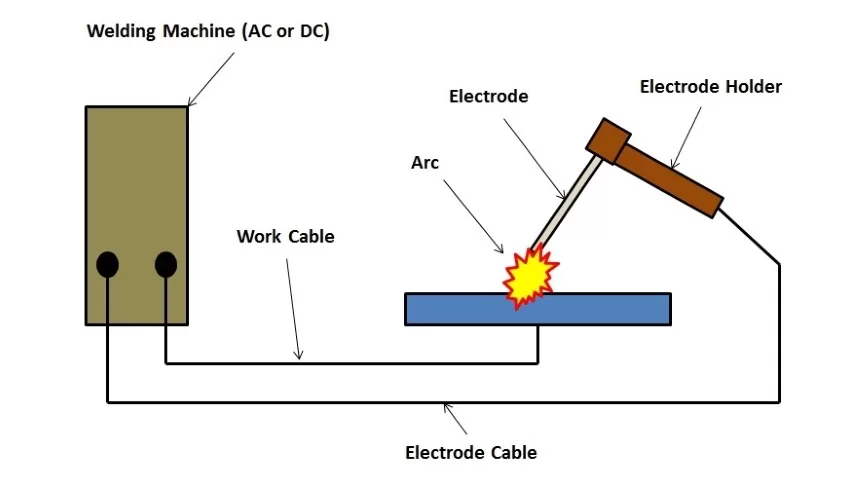
In terms of welding types, the 7014 and 7018 electrodes are designed for arc welding, which has become the most common welding method in the construction industry. According to Tulsa Welding School, Tulsa, Florida Arc welding uses an electric current and a welding electrode to join two metals. The electrode in question can be either a 7014 or a 7018.
While there is no significant difference between the two, you can choose depending on the application.
Welding Position
Before choosing a welding electrode, you must consider its compatibility with various welding positions. This is important because not all welding rods can be used in every position; some can only weld in one or two positions, while others can weld in many more.
To determine the proper weld position for your electrode, you must look at the third digit of the electrode. In the case of 7014 and 7018, “1” is the third digit for both welding rods. The “1” indicates that the electrode can be used in almost any position, including flat, horizontal, elevated, descending, and inclined welding.
However, in practice, using the 7014 vertically, both uphill and downhill, can be a bit tricky. Whilst the 7018 rods are more versatile, they are a little tricky to run vertically downhill.
Tensile strength
The first two digits of a welding rod determine its tensile strength. Since the first two digits of the 7014 and 7018 welding rods are “70”, they have the same tensile strength, i.e., the final weld has a tensile strength of 70,000 PSI.
Final Thoughts
As we suggested at the beginning of this article, telling the difference between 7014 and 7018 electrodes is not a big deal, especially for novice welders. To help you recognise the difference between the two electrodes, we have profiled their characteristics.
By now, you know that 7014 and 7018 have similar characteristics, but they also have some different properties. For example, they have different coatings and storage conditions. You should familiarise yourself with all the differences between 7014 and 7018 before making your choice. If you are a beginner, the ease of use and storage of 7014 soldering iron will help you.
However, if you are a professional, you may prefer 7018 electrodes. In the end, make sure you choose the electrodes that meet your needs.
As a professional welder,not all AC stick machines run 7018 well, even the 7018AC that’s supposedly designed for use on Ac stick machines. 7014 is a good substitute that reasonably matches 7018.
7018 is a low hydrogen rod designed to prevent hydrogen cracking in higher carbon steels. On low carbon steels like A36 or the typical hot rolled bar and plate that most use, you really don’t need a low hydrogen rod. 7018 is a bit more ductile than 7014 is, but for small household projects 7014 will work just fine.
We use 7014 at the tech school as a good starter rod to teach students with. It’s an easy rod to run well for those who are just learning.It’s often referred to as a “drag” rod because you can simply keep the flux coating in contact with the plate as you weld, and if your amps, rd angle and travel speed are close, it will produce a nice consistent weld where the slag peals itself off or is easy to remove.
7014 also doesn’t absorb moisture like 7018 does. Damp 7018 that is improperly stored can weld poorly and you loose that low hydrogen property of the rods. It’s still usually find for small noncode projects even when damp, but the erratic weld quality can some times cause issues with how easily it welds. 7014 doesn’t have those issues with absorbing moisture, so it makes a good rod to keep on the shelf for long times in areas that are often damp like near lakes or the ocean.
I keep a bunch of 7014 on hand for this reason. Given a choice for important projects like my plow, I’ll buy brand new 7018, but for small generic projects around the house 7014 works just as good.







